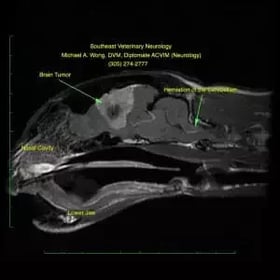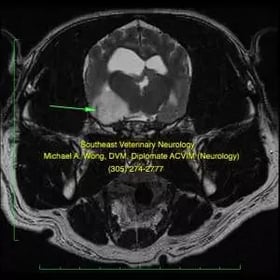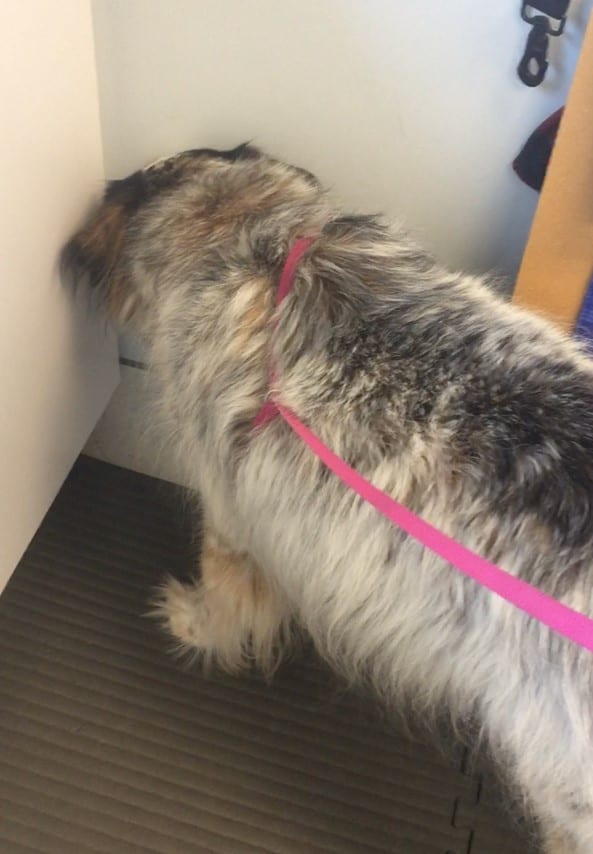Brain Tumors in Dogs and Cats
Home » Conditions We Treat » Brain Tumors in Dogs and Cats
Diagnosing & Treating Brain Tumors
At Southeast Veterinary Neurology (SEVN), we have a team of skilled veterinary specialists with in-depth experience handling complex medical cases, including the management of brain tumors in dogs and cats. While the diagnosis of a brain tumor in your pet might come as a shock, our veterinary neurologists and supporting staff are here to help you through the treatment process at every step. Download the fact sheet.
If your pet is showing unusual signs that could indicate a neurological problem, reach out to us today.
What are the clinical signs of a brain tumor in dogs and cats?
The location of your pet’s tumor will dictate the clinical signs you see, which may include:
- Changes in behavior
- Compulsive circling
- Seizures
- Weakness
- Wobbliness
- Balance problems
- Blindness
ARE CERTAIN BREEDS MORE AT RISK?
While just about any pet can develop cancer in their older years, some specific dog breeds are overrepresented. These include Boxers, Boston Terriers, and Golden Retrievers.
Types of Brain Tumors in Dogs and Cats
Of all the neurological problems that affect pets, especially older dogs and cats, brain tumors are relatively common. Still, why these tumors occur is not easy to answer, as a combination of genetic and environmental factors can contribute to cancer development.
Brain tumors in dogs and cats can be divided into two categories:
- Primary tumors develop from cells that make up the brain itself and the lining of the brain. These include meningioma, glioma, ependymoma, choroid plexus tumors, pituitary tumors, and more.
- Secondary brain tumors are tumors that develop elsewhere in the body and eventually spread to the brain.
Meningiomas arise from the meninges (covering of the brain) and are the most common type of primary brain tumor in dogs and cats. In dogs, they are more common in long-nosed breeds, such as the Golden Retriever. They tend to be slow-growing and compress the brain from the “outside” in.
Also common in pets, gliomas arise from the supporting cells of the brain (glial cells) and include astrocytomas and oligodendrogliomas. In dogs, they are more common in short-nosed breeds, including the Boxer and Boston Terrier. They tend to grow on the ‘inside’ of the brain.
Diagnosing Your Pet's Brain Tumor
Since other neurological diseases can cause identical clinical signs, advanced diagnostics are warranted. High-field MRI is the best imaging tool for viewing and diagnosing brain tumors in dogs and cats. While computed tomography (CT) may show some types of brain tumors, MRI allows us to clearly see the location, shape, and size of the tumor in addition to giving us a much better idea of what kind it is and how we can treat it. Sometimes a biopsy is recommended for definitive diagnosis.

MRI of the brain of a cat showing a meningioma.

MRI of the brain of a dog showing a glioma.
Available Treatment Options for Pet Brain Tumor
Treatment of brain tumors depends on the size, location, and suspected type of tumor. Options for your pet include surgery, chemotherapy, radiation therapy, and palliative medication. Once we’ve diagnosed your pet’s brain tumor and determined the appropriate next steps, we’ll do all we can to make their journey as smooth as possible.


